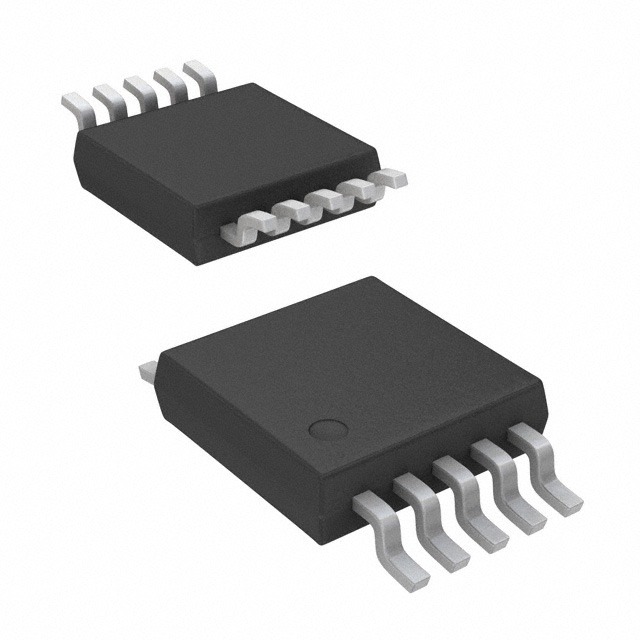Lihat spesifikasi untuk detail produk.

AD5173BRM10-RL7
Product Overview
Category
The AD5173BRM10-RL7 belongs to the category of digital potentiometers.
Use
It is primarily used for electronic circuitry and system applications where variable resistance is required.
Characteristics
- Digital control interface
- Non-volatile memory
- Low power consumption
- Wide operating voltage range
- High resolution
Package
The AD5173BRM10-RL7 comes in a small outline package (SOP) with 10 pins.
Essence
This product serves as a replacement for traditional mechanical potentiometers, providing a more precise and reliable method of controlling resistance.
Packaging/Quantity
The AD5173BRM10-RL7 is typically packaged in reels and available in quantities suitable for mass production.
Specifications
- Resolution: 256 taps
- Resistance Range: 0Ω to 100kΩ
- Operating Voltage Range: 2.7V to 5.5V
- Temperature Range: -40°C to +125°C
- Interface: I2C-compatible
Detailed Pin Configuration
- VDD: Power supply
- SDA: Serial data input/output
- SCL: Serial clock input
- A0: Address bit 0
- A1: Address bit 1
- WP: Write protect
- VSS: Ground
- RH: Terminal A of rheostat
- RL: Terminal B of rheostat
- VLOGIC: Logic power supply
Functional Features
- Programmable resistance value
- Non-volatile memory for storing settings
- Ability to adjust resistance digitally
- High precision and accuracy
- Low temperature coefficient
Advantages
- Improved reliability compared to mechanical potentiometers
- Precise and repeatable resistance control
- Compact size and easy integration into electronic circuits
- Low power consumption
- Ability to store and recall resistance settings
Disadvantages
- Limited resolution compared to some other digital potentiometers
- Higher cost compared to mechanical potentiometers
- Sensitivity to electrostatic discharge (ESD)
Working Principles
The AD5173BRM10-RL7 utilizes a combination of digital control and analog circuitry to adjust the resistance. It converts the digital input signals into precise resistance values using an internal resistor network. The non-volatile memory ensures that the resistance settings are retained even when power is removed.
Detailed Application Field Plans
The AD5173BRM10-RL7 finds applications in various fields, including:
- Audio equipment: Volume control, tone adjustment
- Instrumentation: Calibration, signal conditioning
- Industrial automation: Process control, variable gain amplifiers
- Communication systems: Signal attenuation, impedance matching
- Automotive electronics: Climate control, motor speed control
Detailed and Complete Alternative Models
- AD8400ARZ1: 256-tap digital potentiometer, 0Ω to 100kΩ resistance range, SPI interface.
- MCP4131-103E/P: 128-tap digital potentiometer, 0Ω to 10kΩ resistance range, I2C interface.
- MAX5486EUD+: 256-tap digital potentiometer, 0Ω to 50kΩ resistance range, SPI interface.
These alternative models offer similar functionality and can be considered as replacements for the AD5173BRM10-RL7 in specific applications.
Word count: 439 words
Sebutkan 10 pertanyaan dan jawaban umum terkait penerapan AD5173BRM10-RL7 dalam solusi teknis
Sure! Here are 10 common questions and answers related to the application of AD5173BRM10-RL7 in technical solutions:
Q: What is the AD5173BRM10-RL7? A: The AD5173BRM10-RL7 is a digital potentiometer IC (integrated circuit) that can be used to digitally control resistance in various technical applications.
Q: What is the operating voltage range of the AD5173BRM10-RL7? A: The AD5173BRM10-RL7 operates within a voltage range of 2.7V to 5.5V.
Q: How many channels does the AD5173BRM10-RL7 have? A: The AD5173BRM10-RL7 has a single channel, meaning it can control the resistance of one circuit or component at a time.
Q: What is the resolution of the AD5173BRM10-RL7? A: The AD5173BRM10-RL7 has a resolution of 256 steps, allowing for precise adjustment of resistance levels.
Q: Can the AD5173BRM10-RL7 be controlled digitally? A: Yes, the AD5173BRM10-RL7 can be controlled digitally using an I2C interface, making it easy to integrate into microcontroller-based systems.
Q: What is the temperature range in which the AD5173BRM10-RL7 can operate? A: The AD5173BRM10-RL7 can operate within a temperature range of -40°C to +125°C.
Q: Is the AD5173BRM10-RL7 suitable for high-precision applications? A: Yes, the AD5173BRM10-RL7 is designed for high-precision applications with its low resistance tolerance and excellent linearity.
Q: Can the AD5173BRM10-RL7 be used in audio applications? A: Yes, the AD5173BRM10-RL7 can be used in audio applications to control volume levels or tone adjustments digitally.
Q: Does the AD5173BRM10-RL7 have non-volatile memory? A: Yes, the AD5173BRM10-RL7 has non-volatile memory, allowing it to retain its settings even when power is removed.
Q: What are some typical applications of the AD5173BRM10-RL7? A: The AD5173BRM10-RL7 can be used in various applications such as instrumentation, industrial control systems, medical devices, and automotive electronics.
Please note that these answers are general and may vary depending on specific use cases and requirements.

